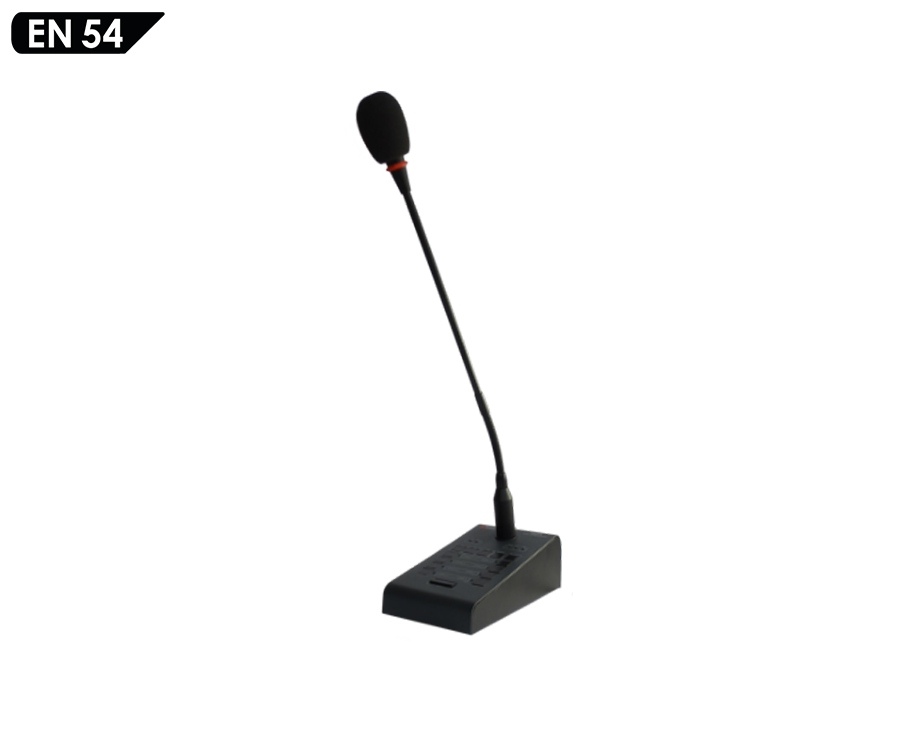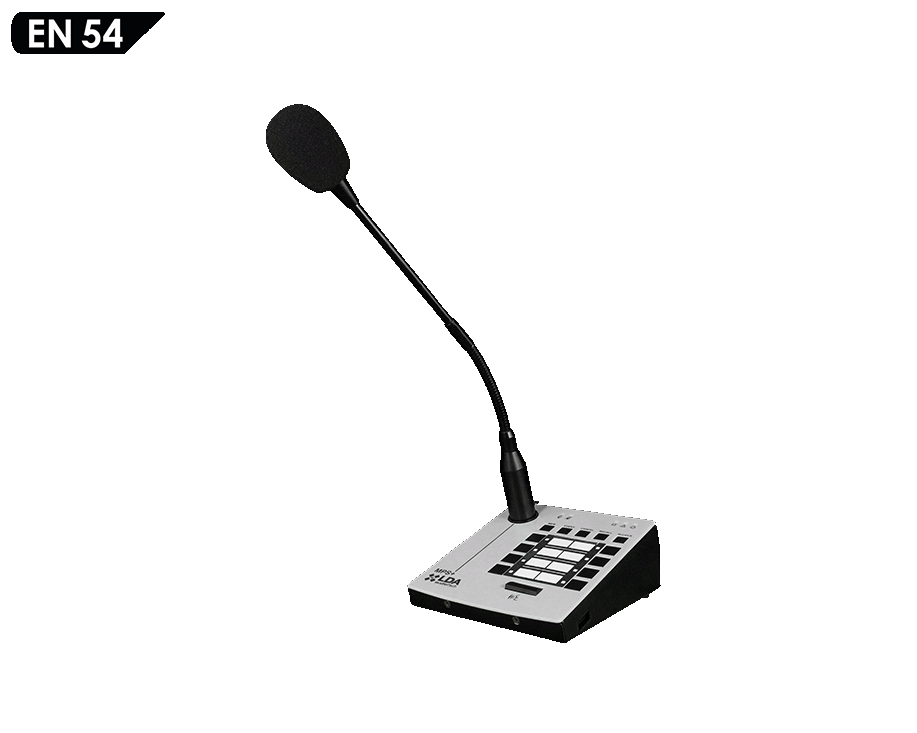
16 Apr MPS-8Z+ Microphone: Advantages and Comparison with MPS-8Z Model
The new MPS-8Z+ microphone has made a strong entry into the LDA Audio Tech portfolio. We are not only talking about an aesthetic improvement in the look & feel of the product, which helps its perfect integration into modern environments, but also new advanced features that are added to this renewed version of a product established in the market and now becomes an all-rounder for large public address projects.
The MPS-8Z+ incorporates version 2 of the ACSI protocol as a major new feature. What does this mean? Among other things, up to 32 devices can now be connected to the same bus directly to NEO, NEO+ or NEXO, making this accessory ideal for PA and voice evacuation systems with many microphones.
Another innovative and differentiating function of the MSP-8Z+ multizone microphone is the Store & Forward feature, which allows a voice message to be broadcast on delay if the system is busy when the user wants to make the call.
But there are many more advantages of the MPS-8Z+ over its predecessor. The new version of the ACSI protocol was released with the v02.40.xx.xx firmware of the NEO devices and has now been integrated into the v02.xx version of the MPS8Z+, taking advantage of its enhanced capabilities and new features.
The ACSI v2 protocol brings many improvements over its previous v1 version. To sum up, these are:
- Up to 32 devices on the bus.
- Faster link process.
- Added groups functionality. It allows to define groups of zones that can be used across the system.
- Improved customization of the zone buttons with the use of zone groups.
- Better feedback information from principal devices to secondary devices.
- Extended status information on the system, its zones and zone groups.
- Information when another device is occupying the bus audio channel.
- Pre-evaluation function of operations before they are executed.
▶ COMPARISON MPS-8Z / MPS-8Z+
* All devices on the ACSI bus should have the same ACSI version. The model MPS-8Z can be upgraded to light v2 version in order to work in same bus with other ACSI v2 devices.
▶ 32 DEVICES ON THE BUS
The v1 version of the ACSI protocol, operating on the MPS-8Z microphone, allowed the connection of up to 8 devices, while v2, which comes standard on the MPS-8Z+, allows up to 32 devices to be connected.
The MPS-8Z+ has two connections for distributed elements in public address systems. The ACSI bus unifies the audio channel of the microphone with the PA system as well as the control and power supply lines in a single cable.
The connection will always be made in daisy chain bus mode, where each device is connected to the next, and via Ethernet network cable with a maximum distance for the entire bus of 1,000 m (3,280 ft).
In addition, thanks to the high connectivity of LDA Audio Tech’s public address and voice alarm systems, up to 4096 units of MPS-8Z and MPS-8Z+ microphones and VAP-1 and VAP1-FES panels can be connected to a single NEO+ system using NEXO converters.
▶ STORE & FORWARD FUNCTION
This function allows a delayed voice message to be broadcast if the system is busy when the user wants to make the call. In this case, the MPS8Z+ is able to store the message in its internal memory for later broadcasting once the system is available again.
When this mode is active, the operation will be as follows:
- If the MPS+ is given a denial response from the master it will first show which zones/groups have been rejected for a while, and then it will pass to record the message (up to 45 seconds).
- During the recording, the message will be stored in the internal memory. This operation can be aborted at any time by pressing CANCEL.
- After the message recording has finished, the MPS8Z+ will go into waiting status for 5 minutes. During this mode, the device will perform periodically a talk request to the master until it gets a positive response. After the 5 minutes have elapsed, if the system is still busy, the message playback will be automatically aborted and can be retrieved by the user with the RECALL function when the system becomes available. If an emergency occurs during the wait, the message will also be aborted.
▶ BUSY BUS FEEDBACK
The MPS-8Z+ can show with an LED indication if the ACSI bus is busy because some other microphone is currently speaking.
This new feature allows the user not to cut off another message being broadcast and to wait to make his call when the bus is idle again. The user can still make the call, although in that case he will only be able to talk if the priority of his MPS-8Z+ is higher than that of the other device.
If all microphones have the same priority on the ACSI v2 bus, the busy bus indication will prevent a new call from interrupting the call already in progress.
▶ WORKING WITH ZONE GROUPS
The ACSI bus with v2 firmware can give gives additional information to secondary devices when it is given a busy response. MPS8Z+ can be aware and show to the user which zones/groups have any conflict so that they can be deselected to perform a new talk request and give the message to the available zones.
By default, the system zones that are assigned to each MPS8Z+ are matched to the system zones (zone memory 1 = system zone 1, memory 2 = zone 2, etc.), but can be customized through the public address system (NEO). Each zone memory may be associated with a zone in the system or a group of zones, depending on the connected system.
For example, NEO systems have up to 64 configurable zone groups with very high flexibility. It is also possible to create groups that call all zones in the system from a single memory key.
With the new MPS8Z+, the user can know which zone buttons have a stored configuration that can be loaded and which do not, allowing more convenient management of public address zones.
▶ CONNECTION TO NEO+ AND NEO+ SYSTEMS
The MPS-8Z+ PA microphone comes factory configured with the ACSI v2 system, although it also supports configuration to the previous version of the protocol, ACSI v1.
The MPS-8Z microphone, on the other hand, comes from the factory with ACSI v1 but can also be upgraded to ACSI v2 to coexist with its successor, the MPS-8Z+, and other devices operating on the upgraded version of the protocol (such as the VAP1-FES fire panels). In these cases, the MPS-8Z will be able to work with these devices although it will not enjoy the extra features of the new MPS-8Z+.
In general, firmware versions v01.xx correspond to ASCIv1 devices, and firmware versions v02.xx correspond to ACSIv2 devices. Both are available for download on our Support website.
To check directly on the microphone which firmware version is installed, the device incorporates a check function. If, when the microphone is switched on, the status LEDs flash twice simultaneously, the device has ACSI v2. If, on the other hand, the status LEDs make a random sequence of power on, the microphone is operating with ACSI v1.
▶ DOCUMENTATION AND DOWNLOADS
If you would like to know more about the new MPS-8Z+ and how it fits into large public address and voice evacuation projects, please send us your inquiry through our usual contact channels.





